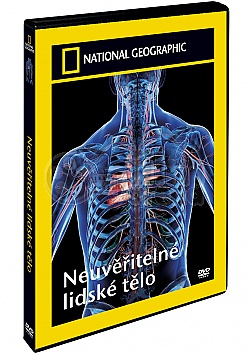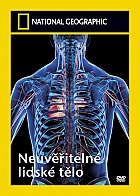Incredible Human Machine
BRILLIANTLY DESIGNED. MARVELOUS IN ITS MECHANICS. THE ULTIMATE INCREDIBLE MACHINE: THE HUMAN BODY
From Steven Tylers Vocal Cords to Olympic Athletes Prowess to Blue Angels Endurance National Geographic Channels Incredible Human Machine Details Extreme Human Feats, Cutting-Edge Medical Science and the Bodys Daily Marvels
Its the most spectacular machine of all time the human body. Every routine breath, step and heartbeat requires a brilliantly designed inner system of instruments, engines, circuitry and software. Marvelous in its mechanics, the body has been stretched and pushed to the limit by the elite few, studied in molecular detail through the ages and imitated in 21st century artificial medical breakthroughs.
On Sunday, October 21, at 9 p.m. ET / 8 p.m. PT, the National Geographic Channel (NGC) presents Incredible Human Machine, a two-hour journey through an ordinary, and extraordinary, day-in-the-life of the human machine. With stunning high-definition footage, radical scientific advances and powerful firsthand accounts, Incredible Human Machine plunges deep into the routine marvels of the human body. Through 10,000 blinks of an eye, 20,000 breaths of air and 100,000 beats of the heart, see the amazing and surprising, even phenomenal inner workings of our bodies on a typical day. And explore striking feats of medical advancement, from glimpses of an open-brain surgery to real-time measurement of rocker Steven Tylers vocal cords.
An update of the 1975 National Geographic classic, Incredible Human Machine shows how our body works in unexpected ways. See how every breath we take follows an increasingly twisted maze of bronchial tubes deep in your lungs. Marvel at the complexity of our soft, smooth skin when magnified 600 times. And follow along as a bite of food travels from the mouth to the esophagus, stomach and then small intestine. By combining images using a broad battery of advanced technology including functional magnetic resonance imaging (fMRIs), Positron Emission Tomography (PET) scans, electroencephalograms, 4-D ultrasounds and high-resolution X-rays the program lets us see ourselves in ways not previously possible.
Though blueprints for every one of us are 99.9 percent identical, the show also zooms in on the elite individuals who push their bodies to the extreme. Aerosmiths lead singer Steven Tyler opens wide and gives us an intimate look at how his famous pair of vocal cords holds up to trauma. After vocal damage forced him to cancel part of the bands tour, a pioneering laser method of zapping blood vessels allowed Tyler to start singing again. Get a front-row seat to see his vulnerable cords slamming together an average of 170 times per second during a live concert the first time this real-time measurement has been done.
Theres no part of the human body that likely sees these kinds of collision forces and stresses, which is why vocal folds essentially wear out over time, says Dr. Steven Zeitels, a laryngeal surgeon at Massachusetts General Hospital, who performed Tylers surgery.
Then, study top-notch individuals who have harnessed the power of their body through rigorous training, including U.S. Olympic pentathlete Eli Bremmer, who trains at more than 6,000 feet above sea level; the U.S. Navy's Blue Angels, whose bodies endure up to nine g-forces or nine times gravity which causes enough pressure to push oxygen-carrying blood out of their brain; and a Buddhist monk who meditates under a frigid waterfall. What allows their bodies to withstand these extraordinary forces and pressures? Can you train your body to withstand extreme conditions? Go inside these incredible human machines to see just how this happens.
Incredible Human Machine also sheds light on the experimental clinical trials and intriguing technology being implemented by top doctors across the country, turning the once seemingly impossible into new hope for many patients. For example, see how a human can be steered by remote control via a special headset that may soon help treat chronic dizziness. NGC shows how an implanted device that acts like a retina allowed nearly blind 62-year-old Linda Morfoot to see lights and movement. A clinical trial that extracts stem cells from hip bones and injects them into the heart helped 49-year-old heart attack victim Michael Carlat to move freely again, his heart now pumping 25 percent more blood than it did before. And a special biological material called extracellular matrix eased 45-year-old Mark Kramers shoulder pain by essentially coaxing his body into fixing itself. All three individuals provide living testimonies to the advanced technology at work and the remarkable resilience and regenerative abilities of the human body.
Finally, its the one system presiding over everything, the organ that truly defines you: the brain. Watch as NGC cameras capture the removal of a cancerous tumor from 23-year-old Brandon Carson. Because the tumor is located near a region of his brain critical for language, UCLA neurosurgeon Dr. Linda Liau keeps Carson awake to test his language capacity during surgery. See striking real-time glimpses into the brain bringing us one step closer to understanding how it all works, and how far we still have to go.
Incredible Human Machine is produced for the National Geographic Channel by National Geographic Television (NGT). For NGT, Chad Cohen is producer, writer and director; Arthur F. Binkowski is producer, editor and director; French Horwitz is the senior series producer; and Eleanor Grant is executive producer. For National Geographic Channel, executive producers are Madeline Carter and Howard Swartz, and senior vice president of production is Juliet Blake.
For more information, visit www.ngchumanmachine.com, starting Monday, September 24.

















